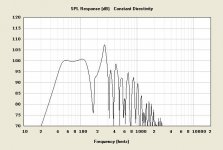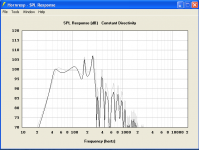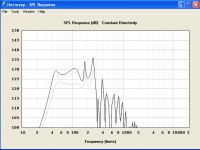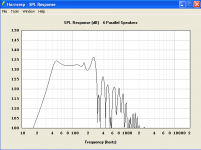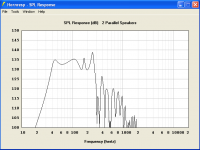Does the main screen still display in cm?
Hi BP1Fanatic,
The main input screen still displays the parameter values in metric units.
The F6 function key can be used to show the equivalent Imperial value for a selected parameter, to 4 decimal places.
Kind regards,
David
The standard version THAM15, the only one with propper drawings published is the one, but feel free to modify it as you see fit, there has been numreous proposals on how to improve their prefomrance, such as aperture chamfer, cone compensators, and various reflector proposals.
I have not looked into all of these myself, but scan the forums and ask around if you feel up to it, I'm sure you will find alot of inspiration out there.
Most people seem very happy leving it as it is, the most common modification is only adding a bit of depth to the box in order to fit a full front cover, this does not impact on or alter the design.
I have not looked into all of these myself, but scan the forums and ask around if you feel up to it, I'm sure you will find alot of inspiration out there.
Most people seem very happy leving it as it is, the most common modification is only adding a bit of depth to the box in order to fit a full front cover, this does not impact on or alter the design.
A have alredy built first version.. It's simplest. Loaded with B&C 15PS76 and i'm very satisfied with performance. Tone is exactly what i have been loking foor. Excelent for deep and tech house, and also usable for drum&bass. Nice, clean tone, and non-electronic genres also sound nice. Also has a very good thump, tested on 2 parties, outdoors and nothing but kudos for sound.  Sound is so big. Thank you man very much for this design.
Sound is so big. Thank you man very much for this design.
More pictures and videos are available here:
https://www.facebook.com/djserviskula?ref=hl
More pictures and videos are available here:
https://www.facebook.com/djserviskula?ref=hl
An externally hosted image should be here but it was not working when we last tested it.
Nice job ! It's allways great to see what dedicated and skilled DIY'ers get up to with the THAM's, it seems that the THAM15, the first THAM design, is the most popular folowed by the THAM12, at least so far.
The THAM18 is starting to gain momentum in asia, it seems that Asia along with Russia are the fastest adopting markets for the newer THAM designs while US and Eurpoe are more conservative and theoretical in their approach to new designs.
The THAM18 is starting to gain momentum in asia, it seems that Asia along with Russia are the fastest adopting markets for the newer THAM designs while US and Eurpoe are more conservative and theoretical in their approach to new designs.
Tham 15 was chosen by me simply for size and freq response. I have built previously MTH-30, which doesn't have that low response, its about 10hz higher, but i liked character of the tone. So, my assumption was that THAM-15 would be best suitable design. (it's little heavier that i want, but not too bad)..
Question is this.. At which frequency do you crossover this box and tops. I currently have EV SX-300 like tops, crossed over at 120Hz. Everything sound great with, deep, tech, dub, and other types of music with deep articulate bass.. But with trance, current EDM hits, and other content where there is no sub frequencies, i have impression that simple bass reflex boxes tuned higher is all i need, this types of music is like produced wit trashy sound systems in mind
Question is this.. At which frequency do you crossover this box and tops. I currently have EV SX-300 like tops, crossed over at 120Hz. Everything sound great with, deep, tech, dub, and other types of music with deep articulate bass.. But with trance, current EDM hits, and other content where there is no sub frequencies, i have impression that simple bass reflex boxes tuned higher is all i need, this types of music is like produced wit trashy sound systems in mind
For intended high power applications (~1kw) using high end drivers :
HPF 40Hz 24dB/Oct* - LPF 140Hz 24dB/Oct*
*/ Prefered if possible - 48dB/Oct (usually granted by most modern procerssors)
For lower power applications the HPF may be set lower, ~ 30Hz.
Make sure your dirvers can handle the power, the above (top) high power applications senario is amied against ~2kw ~10mm xmax drivers such as 15TBX100 and the like.
The advantages using a tapped horn design is not only limited to very good volumetric efficiency (dB/dm3) over it's given operating range (even if range limited compared to Br designs) but it also adress sound quality, this is to some extent subjective, but SQ is the most noticable feedback I recieve for all the THAM designs to date, I hope you feel they where worth the time spent on build and money spent on drivers.
HPF 40Hz 24dB/Oct* - LPF 140Hz 24dB/Oct*
*/ Prefered if possible - 48dB/Oct (usually granted by most modern procerssors)
For lower power applications the HPF may be set lower, ~ 30Hz.
Make sure your dirvers can handle the power, the above (top) high power applications senario is amied against ~2kw ~10mm xmax drivers such as 15TBX100 and the like.
The advantages using a tapped horn design is not only limited to very good volumetric efficiency (dB/dm3) over it's given operating range (even if range limited compared to Br designs) but it also adress sound quality, this is to some extent subjective, but SQ is the most noticable feedback I recieve for all the THAM designs to date, I hope you feel they where worth the time spent on build and money spent on drivers.
I have measured response, and is very close to calculated. I'm using grill which is probably little more dense than it should.. probably about 50% open.. (Purchased and received this grill by mail, i was expecting something with bigger holes). To my surprise, response did not change in output, but there is a small change in response.. about 50Hz response is little stronger with grill (1-2 db), and dip around 170 Hz is deeper. I measured this with relatively small power.. maybe 10V..
My question is, if response in db is not much changed with small volume signal, when i apply bigger power, is it output also sustained with grill? Or there is a possibility for lower then max signal ?
My question is, if response in db is not much changed with small volume signal, when i apply bigger power, is it output also sustained with grill? Or there is a possibility for lower then max signal ?
The frequency response change the grill affords should be linear regarding power.My question is, if response in db is not much changed with small volume signal, when i apply bigger power, is it output also sustained with grill? Or there is a possibility for lower then max signal ?
That said, in high power tests of a TH (different design than the Tham) I found the upper response to reduce at high volume, compared to using the same speaker in a bass reflex cabinet where low frequency response was reduced at high volume.
This driver below looks like some type of B&C clone. I have built a pair of THAM15's using the Dayton 380 speakers and they sound great but are limited by 5mm xmax. I'm wondering if I would be better served to switch to the new PA385 or just build another pair with the PA380. Is there a an ipad compatible version of horn-response? Thanks.
Dayton Audio PA385S-8 15" Pro Subwoofer 4" VC 8 Ohm | 295-040
Dayton Audio PA385S-8 15" Pro Subwoofer 4" VC 8 Ohm | 295-040
This driver below looks like some type of B&C clone. I have built a pair of THAM15's using the Dayton 380 speakers and they sound great but are limited by 5mm xmax. I'm wondering if I would be better served to switch to the new PA385 or just build another pair with the PA380. Is there a an ipad compatible version of horn-response? Thanks.
Dayton Audio PA385S-8 15" Pro Subwoofer 4" VC 8 Ohm | 295-040
Hey there - I am trying to master Hornresp myself, so I will see if I can be of assistance to you. I actually modeled this comparison about a month ago when I first saw the Dayton PA-385S was being introduced. I have four attachments, here is what they are:
Attachment #1 - The grey trace is the PA380 @ 1 watt, the black trace is the PA385S @ 1 watt.
Attachment #2 - The grey trace is the PA380 maxed out at 200 watts. The black trace is the PA385S maxed out at 800 watts.
Attachment #3 - This is four of the PA380 drivers maxed out at 800 watts @ 2 ohms.
Attachment #4 - This is two of the PA385S drivers maxed out at 1600 watts@ 4 ohms.
I am no expert on this, but I believe these calculations should give you a pretty good idea what to expect in the two scenarios you mentioned. It looks like you would come out about the same for Max SPL either way.
I guess it really comes down to if you want to build two more cabinets and spend $150 on speakers, or not build any more cabinets and spend $400 on speakers. I would also take into consideration you amp, and if it can run safely at 2 ohms if you are going to be running four of the PA380 drivers on one amp channel. If you go with the PA385S, do you have an amp with that much power, or can you bridge you amp to achieve that much power?
Attachments
Last edited:
I have not built this particular cabinet, but have lots of experience with cabinets with a similar LF response.For those of you who have built this TH, subjectively, is the bass extension deep enough for most music?
I mostly listen to rock with some classical and electronica, no pipe organ music.
The Tham 15 is a very good compromise for size, sensitivity, and LF response, but is around -6 dB at 40 Hz. Excursion rises rapidly below that point, so it can't produce clean high SPL output below 40 Hz.
With much modern rock having quite a bit of output to 30 Hz, I notice when a cabinet is not making it to 40 Hz.
Many (if not most) bass guitars are now 5 string, the low note has gone from a low E at 41 to a low B at 31 Hz.
If you are not familiar with hearing LF extension that low, you won't miss it, but after hearing it, it makes a big difference.
Subjectively, I find a the difference between loosing the 1/3 octave from 40 to 30 Hz similar to loosing the 1/3 octave between 12,500 and 16,000, with the exception that there are frequent musical fundamental notes in the lower range, but none in the higher range.
Art
- Home
- Loudspeakers
- Subwoofers
- THAM15 - a compact 15" tapped horn
